Nvidia GeForce GTX 880M GPU Tested: How Powerful Is It?
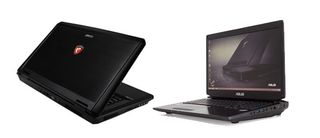
Nvidia's new GeForce 800M series graphics cards for laptops is chock-full of features, from a new Battery Boost mode for extending your unplugged playing time to ShadowPlay for sharing your virtual triumphs (and drooling over others). But ultimately gamers want to know one thing: how fast is it?
According to Nvidia, gamers should see up to a 60 percent improvement in the GTX850M GPU from the GTX 750M, which tapers down to a 15 percent bump for the highest-end GTX 880M. To test Nvidia’s claims, we pitted two notebooks with the new GTX 880M GPU against systems with the previous-generation GPU from Nvidia, as well as one with AMD’s high-end Radeon R9 M290X GPU. Here’s what we found.
MORE: Best Gaming Laptops 2014
The Test Laptops
ASUS G750JZ-XS72 ($2,999): Nvidia GeForce GTX 880M GPU w/ 4GB DDR5, Intel Core i7-4700HQ, 32GB RAM
MSI GT60 DominatorPro ($2,399): Nvidia GeForce GTX 880M GPU w/ 8GB GDDR5, Intel Core i7-4800MQ, 16GB RAM
The competition:
Alienware 17: NVIDIA GeForce GTX 780M w/4GB GDDR5, Intel Core i7-4800MQ, 16GB RAM
Stay in the know with Laptop Mag
Get our in-depth reviews, helpful tips, great deals, and the biggest news stories delivered to your inbox.
Alienware 17 (AMD): AMD Radeon R9 M290X w/4GB RAM, Intel Core i7-4700MQ, 16GB RAM
MSI GT60 20D-026US: NVIDIA GeForce GTX 780M w/4GB GDDR5, Intel Core i7-4800MQ, 16GB RAM
Test 1: 3DMark Fire Strike
One of Futuremark’s newer graphics benchmarks, 3DMark Fire Strike tests DirectX 11 performance on higher-end GPUs by rendering highly detailed graphics in real time.
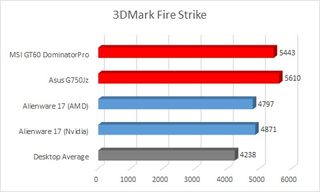
On this test with Nvidia’s newest GPUs, we saw a clear jump in performance, as the two systems with the 880M chip scored in the mid-5,000 range, more than 700 points better than the 780M GPU in the Alienware 17.
Test 2: World of Warcraft
Although it’s not the most demanding of titles, the popularity of “World of Warcraft” makes it a good litmus test for all types of notebook GPUs. Considering we were comparing high-end graphics cards, we set the effects to Ultra, and the screens to 1920 x 1080.
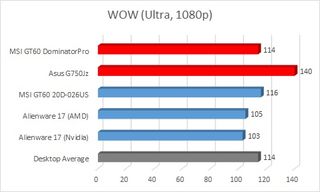
Here again, Nvidia’s newest GPU flexed its muscles, pushing the Asus G750Jz to 140 fps. The MSI GT60 DominatorPro averaged 114 fps, but that was with the resolution at 1920 x 1200, the nearest compatible resolution. Tellingly, when we increased its resolution to its native 2880 x 1620, the MSI averaged 101 fps--nearly the same as the two Alienwares at 1080p.
Test 3: Bioshock Infinite
We ran the Bioshock Infinite benchmarking utility at two settings: The first on Low (option 7 in the utility), and the second on UltraDX11_DDOF (option 2 in the utility). In both cases, the new Nvidia GPUs managed to squeeze out nearly 20 more fps than the previous version, as well as AMD’s last-gen GPU. Getting over 60 fps on high is absolutely blazing.
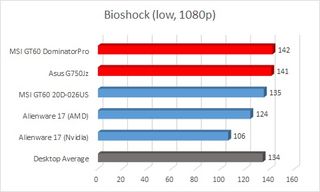
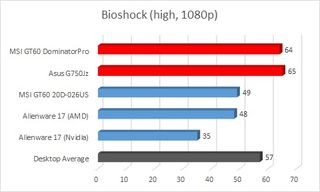
Test 4: Metro Last Light
This gaming test proved to be the great equalizer. Like Bioshock, we ran the built-in benchmark at two settings, but saw little difference between the new and old GPUs.
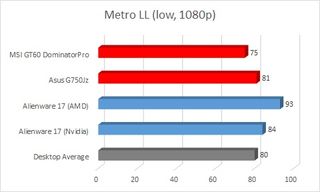
On Low, Texture Filtering was at AF 4X, Motion Blur was Low, SSAA was unchecked, DirectX 11 Tessellation was off, and Nvidia PhysX was unchecked. With the resolution at 1080p, the Asus G750JZ averaged 81 fps, and the MSIGT60 averaged 75 fps. Both are very good numbers, but no better than the average, the previous Nvidia GPU, or the AMD GPU.
We then cranked Metro LL’s settings to Very High, with Texture Filtering at AF 16X, Motion Blur Normal, SSAA checked, DirectX 11 Tessellation on High, and Nvidia PhysX checked.
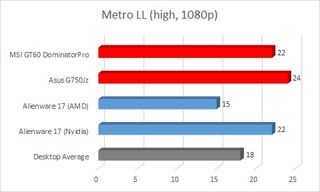
On these settings, none of the notebooks passed our playability threshold of 30 fps, but the ASUS G750JZ (24 fps) and MSI (22 fps) did slightly better than the 18 fps average, as well as the older Alienware units.
Bottom Line
In most cases, gamers will see a clear improvement in performance with the Nvidia GeForce GTX 880M, but the really demanding titles will put a strain on any rig, no matter the graphics chip. Overall, though, we found that the new Nvidia GPU delivered. Stay tuned for our full review of two of the first systems to feature the new card, the ASUS G750JZ and the MSI GT60 DominatorPro.
